Previous Features
My Wonderful Week
By Lenore Tetkowski - 4/4/13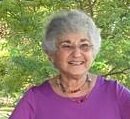
When I was handed the award envelope for having won the "People¹s Choice" at our last Weavers' Guild of Buffalo Exhibit, I was very pleased, and expected a more typical little gift. I won a week's tuition at the John C. Campbell Folk School in North Carolina! It would be valid for a year, so I studied the catalog a long time. When I decided on Anita Luvera Mayer's workshop and sent in my registration information, I was called and informed that it was cancelled! It may surprise you that then I chose "Creative Nonfiction Writing". A big part of the whole experience was getting there. I flew into Atlanta as recommended and was met by the Folk School van's friendly driver. We chatted and I dozed on the two-hour drive north. The School is 5 miles from Tennessee and five miles from Georgia in the southwest little blip of North Carolina deep in Appalachia. After a warm welcome I gradually mingled with all the other creative folks, and enjoyed a big attractive delicious dinner together. All the meals were outstanding with a vegetarian buffet in addition to regular fare. We were encouraged to eat with different groups at each meal to get to know everybody. I shared a lovely room in a cottage with a roommate from South Carolina taking painting. Classes were spread out in studios over the campus-like grounds. I enjoyed walking on woodland paths and visited most of them.
Everyone was welcome to take part in early morning folk singing accompanied by banjo or guitar or fiddle, late afternoon programs and evening programs. So I got to experience lots besides my actual writing course. There was traditional "Broom Making", "Blacksmithing", "Stained Glass", "Glass Bead Making", "Beginning Guitar" and "Quilting", "Painting", "Tapestry Basics", "Woodcarving" and "Building a Dulcimer". Tommye McClure Scanlin is an accomplished tapestry weaver, who told me she would be interested in doing a workshop for our Guild. Each week the program varies. There were three men with me in our writing class with an excellent teacher, Carol Crawford. She had a way of getting us to write personal essays and getting rich feedback from each other. Each member was unique and we really bonded by the end of the week. When they realized how old I am, they strongly encouraged me to continue to write my memoirs.
This Folk School provides a unique way to develop inner creative growth and social development as caring members of a community. It is a non-competitive, peaceful, beautiful, supportive interlude in this hyperactive world. Many thanks to the Weavers' Guild of Buffalo for providing this week for me.
My Christmas Memories - 2012
By Teddy Linenfelser - 12/20/12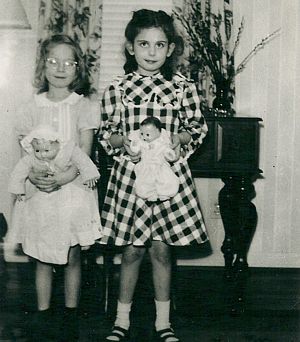
"This is a story of my childhood Christmas memories. My family, the Klingel family, moved to Love Road on Grand Island in March 1942 - our parents, Ted and Marion, and my sister, Mary Ellen and I. I made my first appearance in June, just three months after our family took over a brand new house in Grandyle Village.
Childhood Christmas memories are the best and it’s a good idea to write them down because as years go rolling by, we just won’t remember them as clearly as we did in the past. My earliest Christmas time memories are of little moments from different years. I remember on my third Christmas finding a little wooden wagon full of alphabet blocks in the hallway of our Love Road house. What a surprise to find it later that day. Evidently, Santa stopped back when no one was looking, after forgetting to leave this little treasure that I loved so much.
On Christmas Eve 1947, my dad hooked up our doorbell to ring in the basement. He had my sister and I come down to the basement, the doorbell rang and we raced upstairs to see who was there. No one was there but there was a big box in our breezeway. My father brought it to the kitchen table and opened it. It was a record player and six 78 rpm Christmas records, such as Bing Crosby’s White Christmas. My sister and I were sitting across from one another at the table, leaning on our folded arms, listening to the music. Unfortunately, I leaned on a record and it broke. Then my sister did the same thing. Mom was very disappointed but didn’t say anything. So our Christmas records then numbered only four. Our dad knew the man who would change the records in the Fire Company jukebox from time to time and give my father some of those being replaced. Our record collection grew and grew at no cost to anyone.
The Christmas that still stands out so clearly is that of 1949. I was a second grader in Mrs. Marion Long Young’s class, going to school half days with my classmates, about 38 of them in our classroom, the one across from what is now the office at Sidway School. Mrs. Young asked that we bring in a quarter for a metal project that would turn out to be our parents’ Christmas gift. Mine was going to be a horse. However, I came down with Scarlet Fever on the Saturday of the children’s Christmas party at the Fire Company and didn’t go back to school until a few weeks after the holidays. I woke up that morning, having dreamed that I had glass in my throat. Dr. Norm Stessing, the Island's family doctor, came to the house and diagnosed my illness as Scarlet Fever, a more severe case of Scarlet Tina that was making the rounds on the Island. My father did go to work but my mother and sister, Mary Ellen and I were quarantined. Nothing I touched could be passed on for my sister to look at. That meant when the mailman delivered get well cards and little packages, Mary Ellen had the first look. Those were the days when everyone sent get well cards through the mail. I also received some "Little Golden Books."
My mother, who as I remember never spent a lot on clothes nor bought anything she really didn’t need, had called up a Buffalo department store and ordered a red dress for the New Year’s Eve party being held at the fire hall. The dress was delivered, but she sent it back, knowing she would not be able to go to the party.
Each night leading up to Christmas, Mom would come into my bedroom to help me say my prayers and we would talk. I always asked what she thought Santa Claus would bring me. Mom answered the same thing each night, “I don’t know what it will be but it will be in a big brown bag.” She later said she just made up that story. On Christmas Eve we heard a loud knock on the front door. It was Santa, himself, and he had a big brown bag that he set down on the floor for us. It was a darling, little black and white puppy. We named him Jingles.
Santa Claus had visited our house other Christmas Eve nights. Though I honestly don’t remember this happening, I do remember my mother telling the story. Mary Ellen and I were about three and four years old, and our parents let us stay up and watch them decorate the Christmas tree for the very first time. As I remember her telling it, Santa’s visit that night was a complete surprise to our parents and very exciting for us.
My next door neighbor, Ricky Stefik, sent me a video of his family’s home movies back in the day. Santa Claus is pictured in the movies and certainly does resemble Fred Redinger, a volunteer fireman and a man who loved children. Fred collected used toys over the year and fixed and painted them to look brand new. He delivered them to needy families to make sure that all children on the Island had a merry Christmas.
Those early years brought us toys of all kinds - dolls, doll dishes, doll clothes made by our aunt, bead sets, games, books, stuffed animals, and for me, little musical instruments, such as a mouth organ (harmonica), a squeeze box (toy accordion), and a ukulele.
The Christmas times when we were a little older are the ones I love to look back on. Practicing for the Christmas plays at Sidway School was so much fun. We spent little time in class as we did a lot of rehearsing. One year, possibly 1954, all of the girls in Sidway’s Jr. High pinned jingle bells to our skirts and the music, to our ears, during the change of classes was magnificent. It didn’t last long as our principal, Miss Veronica Connor, deemed it too distracting.
Wearing our green and white robes and singing during the Christmas concerts in the gym in those years is another favorite memory. Mrs. Carol Thompson, director the Sidway School Junior High "Glee Club," also hosted a "dress-up" Glee Club Christmas party. She helped to make this "a most wonderful time of the year" for me.
Why not start your own collection of holiday memories?
Kaegebein Cornerstone/Time Capsule History Shared
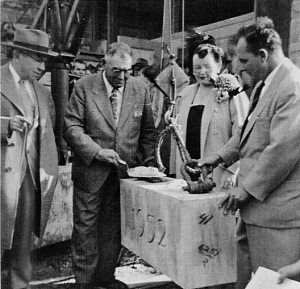
(left) Architect Roswell Pfohl, William Kaegebein, Veronica Connor and State Senator John H. Cooke
School District employee Clyde Hickok provided the informationPosted by Teddy Linenfelser - 11/15/12
"Well, it really was quite exciting for me being an "islander" and knowing what we might find inside (the cornerstone). I originally found a picture of the cornerstone being placed in 1952 (see above). School District Principal Veronica Connor was in the picture along with William Kaegebein and a couple of other folks. The article said that there were some pictures, coins, stamps, money, school papers, and a couple of local newspapers contained in the time capsule. So I passed this information along to the principal at Kaegebein, Mary Hagerty, so she was aware of what may be in it. A couple of weeks after that Supervisor of Buildings & Grounds Tom Rachow asked us if we thought we could do this (removed the cornerstone) without damaging anything. So we made some calls and came up with a plan on how we were going to do this. A few days later we loaded up our tools and went to work. First we had to remove the capstones on top of the wall. They were very heavy. After that we chipped away the mortar from the bricks, and finally got to the cornerstone. The plan was to lift the stone enough to get the lifting straps underneath. When we lifted the one end, Keith Dodge tried to slide a 2 x 4 piece of wood under the stone, and when he did, he said he heard and felt something under there. He said, "lift it higher. I think the box just fell out." Well the box was inside of a hollowed out pocket at the bottom of the stone held in by these small wooden wedges. When he slid the wood under there, he dislodged two of the wedges and the box fell out. We got the box out and it was all copper, approximately four inches square and 12 inches long. The top was sealed with lead. We took it back to the shop and cut the end off, and then brought it back to the principal. She opened it up and there they were, all the things the news article referred to. There were class pictures from Sidway School taken from inside the building on the south end looking out towards Baseline Road. And there was just all open fields, no plaza, no anything. The pictures had all the names of the students on the back. Then there was this scroll that had a ribbon around it. When Mrs. Hagerty unrolled it, it had all the signatures of the teachers and school board members on it. They even included the pen they used to sign it. Some of the names were some of the teachers I remember having: Lillian Shear, Henry Fessard, Gertrude Radius, just to name a few. Then there was an old Island PennySaver in there, what a hoot, the advertisements brought back some memories, and I have to tell ya I had a lump in my throat looking at them. Mayer's Pop on Baseline Road, Godfrey's groceries on Whitehaven, Reese's grocery store on Express Highway, the Esso Station, Karl Buerig's Sunoco Station, Carline's store on Baseline, Batsford's Delicatessen on East River Road (now the Beach House), Grand Island Lumber and Builders Supply, Alt Chevrolet, and Elmer R. Webb Excavating. These are all I can recall right now. There was a silver certificate one dollar bill, a couple of air mail stamps. It was quite a trip down memory lane I'll tell ya. So we left the contents with the principal, and we re-assembled all the stone work, and it doesn't even look like anything was disturbed."
Editor's note: All of the work was done by Clyde Hickok and Keith Dodge of the Buildings and Grounds Department of Grand Island Schools.
See Kaegebein School History, written for the school's 50th anniversary celebration.
Eagle Park Tragedy Revisited on its 100th Anniversary

Click map for larger view
By Teddy Linenfelser - 6/21/12An old fashioned family river picnic sponsored by the Court Amherst Foresters of America was being held at Eagle Park on Grand Island's West River 100 years ago. Nearly 300 Foresters and families gathered Sunday morning, June 23, 1912 to take the ferry boat ride from the Black Rock area of Buffalo to the park, located in what is now in the 2500 block of West River Road.
Courier-Express feature writer, Charles Sennet, reported the following on June 18, 1972. "Shortly after 8 p.m., when the day of games and other entertainment were carried out and enjoyed immensely, the group gathered near Eagle Park dock, waiting to board the steamer, Henry Koerber, rapidly approaching and flanked by the tugboat Lottie Koerber. The bright sun was just braking over the horizon as the joviality continued."
In a June 1970 edition of the Buffalo Evening News, Ralph Dibble wrote the following. "It was the end of a pleasantly sunny Sunday as the crowd of more than 300 persons edged out onto the dock to await the passenger boats that would take them back to Buffalo."
The mood was joyful and two sisters sitting on the top of the ramp leading to the dock began singing. The crowd joined in singing and swaying to the new song, "Everbody's Doin' It Now." The pier full of people were also dancing the newest dance craze, "The Grizzly Bear." The pier started swaying. Park help shouted to get some of the people back off the overloaded pier.
According to an old newspaper article, Mr. Ailinger, 82, on board the steamer, said he was in the pilot house wheeling and recalled that Capt Frank Fix came up to take the wheel for the landing and said, "John, look over at the dock. Some day you are going to see that dock go down." Ailinger said, "It was about five minutes later when it happened. The gang on the dock made it sway something awful. We were about a foot from landing when it happened," he said.
The pier split in the middle and then plunged downward. People dropped into the water in waves, according another newspaper report.
The Koerber's captain, Frank Fix, was quoted in the Buffalo Morning Express, as follows: "I thought there were too many people on that dock and from the bridge I saw the planking begin to sag. I yelled to my engineer, Jerry Raines, and seven or eight of the crew, and we began throwing in life preservers. We had about 30 and they all went in."
The dock was rotten and broke in the center. A section of the dock 54 feet long split in the center and the half of each side hung along the piling, trapping 150 people in the space, struggling in a mess of beer kegs, and empty soft drink cases in the nine mile current. This is from a letter from Kenmore resident Walter Manthei, 76, written to Town Historian, Marion Klingel in 1966. Manthei was one of two last living survivors of the disaster.
Women and children were trapped by the collapsed planking and unable to fight back to the surface. It has been said that about 260 persons went into the water and about 224 of them were saved. The number of deaths is listed as 39. Mr. Manthei confirmed this, saying also that all of the dead were recovered with the exception of one tiny infant who, it was believed, went over the falls not far away.
In Walter Manthei's letter he closed with this. "This face came to mind as I am closing, the most important man there. He attended the injured and gave instruction to those working on the nearly drowned people. Quite a few were injured by falling timbers and flesh being torn by long protruding spikes. One girl had one side of her breast nearly torn off. It was Doctor Sperry who attended to all of these emergencies. He was there as one of the picnickers and it was very fortunate we had him there or many more lives would have been lost. Doctor Sperry asked for someone to go to the tavern and get a bottle of 100 proof whiskey for sterilization of the wounds. A Mr. Miller was the owner of the tavern and refused to give it without pay. Walter Lynch came to the rescue by jumping over the bar, taking two bottles and rushing them to the doctor.
Monday, the day after the tragedy, was a day of even greater horror. The grim scene was unsupervised and drunks and "ruffians" handicapped efforts of the medical examiner and assistants. The boathouse was used as a morgue and corpses were robbed of jewelry and clothing, a truly gruesome sight. This was a part of Ralph Dibble's story in the Buffalo Courier in 1972.
Eagle Park was founded by Henry Cook in 1889. Ellis Dilliot, one of the oldest Island residents, built the wooden dock in 1890 at which time Ike Miller bought the park from Captain Cook. An addition to the dock was added in 1897.
A plaque will be dedicated at 1 p.m. Sunday, July 1st at the south end of the Whitehaven Overlook at 2715 West River Road in remembrance of the 39 souls who lost their lives.
See also Buffalo Newsfeature by Marwa Eltagouri
Charlotte Sidway School Celebrates 75th Anniversary - 1937 - 2012
By Teddy Linenfelser, Town Historian, Grand Island, NY
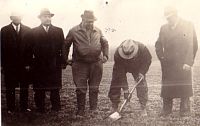
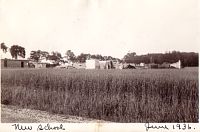
Ground breaking ceremonies on March 16, 1936 - (right) Under construction in June 1936
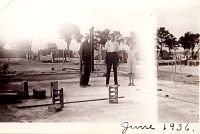
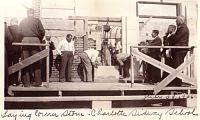
June 1936 - (right) Cornerstone laying July 30, 1936
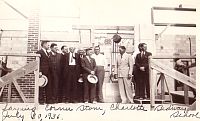
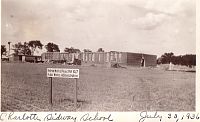
Cornerstone laying July 30, 1936 - (right) Construction progress August 6, 1936 (the sign reads Federal Works Project NY 1027 - Public Works Administration)
Click photos for larger view
These 1936 photos are from the Elsie E. Stamler collection and show progress on the Island's first central school, Charlotte Sidway School. The building was ready for occupancy on February 1, 1937 bringing an end to the one- and two-room schools on the Island.
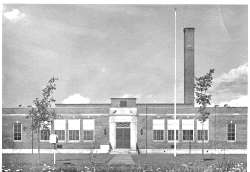
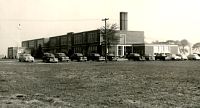
(Left) The New Sidway School - (Right) Sidway in 1950 - Click photos for larger view
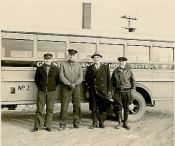
The School District's three bus drivers who also served as custodians when Sidway School opened in February 1937 were (left) Tom Benton Sr., Clarence Schutt, and Henry Landel (right). Heber Ashley (2nd from right) was chairman of transportation. - Click photo for larger view (Elsie Stamler collection)
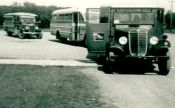
This February 1937 photo was taken as the buses lined up on the south end of Sidway School - probably on the day it opened for the first time. - Click photo for larger view (Elsie Stamler collection)
Education on Grand Island dates back to 1835 according to what has been written by historians of that time. The following is a history of Charlotte Sidway School, a major breakthrough in Island education.
Grand Island, in the years just preceding the birth of the bridges, was a rural and beautiful community with homes and farms widespread, a few stores, two churches and several one-room schools. With the bridges giving easy access to our quiet little Island, more and more mainlanders were discovering its tranquil beauty and Grand Island began to grow.
The idea of a central grade school was put to a vote as early as 1928. People were undecided as to its merits, and the ability of the district to pay for the new school. In 1934 options were obtained on property for a school site. After forwarding plans to Albany, voters turned down the first proposition June 1, 1935, 80 to 63. Two weeks later the vote was 140 to 102 to build a school.
Centrally located, the Chamberlain property on Baseline Road, not far from Express Highway, (GI Blvd.) was purchased and ground was broken March 16, 1936.
A cornerstone was laid July 1936. The cornerstone box contains a copy of the Grand Island News; several 1936 coins; school financial reports for 1924 and 1935; minutes of meeting at which board members voted on school's construction; a resolution sent to Washington and one approving the bonds; names of all town and school board members and two copies of Trinity EUB Church bulletin.
James W. Kideney of Harboch and Kideney, architectural firm, designed the first phase of Sidway School. The one-story brick building opened with four classrooms, a "large" auditorium/gymnasium, an office, and a fully-equipped kitchen. A donation of $1,600 by the Sidway family was used to furnish the kitchen, and in turn the school was named for Charlotte Sidway. One room was used as a store room and another as a music room. Miss Veronica Connor was the principal and also continued to teach 7th and 8th grade as she had at School #5 on Bush Road near Baseline. Other faculty members in 1937 were Miss Jeanette Cady, Virginia Dunker and Miss Velma Golde, as well as Edith Jaynes, a part-time music teacher. Total cost of Sidway was $93,355 with much of the work being done as part of the (Public) Works Administration Project (W.P.A.). With approximately 100 children enrolled, the opening of Sidway School on February 1, 1937 meant the end of Island one- and two-room school houses.
In 1947, Sidway's enrollment increased to almost 400 students. A second story and kindergarten were completed that year, doubling the school's capacity again. When a change in classification from rural to a centralized school district was accomplished in 1948, available state aid was doubled. Continued population increase made it necessary to plan and construct another enlargement, doubling the school's size. The addition included junior high classrooms, a second kindergarten, a cafeteria, home economics room and an industrial arts shop. Completion of the second addition in 1950 ended half-day sessions in lower grades and marked the beginning of a junior high school program on Grand Island.
With the Island's population reaching over 3000 in 1950, a second elementary school, named for William Kaegebein, opened at Love Road and Beaver Island Parkway in 1953. Huth Road School opened in 1958 with an enrollment of over 600, and Sidway became the junior high school with grades 7, 8 and 9 attending. When the new Junior Senior High School opened on Ransom Road in September 1963, Sidway housed grades K-6 from various sections of the Island. In September 1968 a middle school was built adjacent to what then became the high school, at which time Sidway housed grades K-5. A $400,000 renovation of Sidway in 1976 updated the school completely.
Sidway's doors were closed in 1983 when the school was no longer needed due to declining pupil enrollment on the Island.
The history of the school, its opening, adding to, renovating and closing doesn't end there. In 1990 more room was needed for the growing elementary school enrollment.
September 20, 1993 was the first day of Grand Island's new, all-day, developmental kindergarten program at Charlotte Sidway School. A major renovation project was completed in the fall of 1993 when the school opened after being closed for 10 years.
When Sidway's first principal Miss Connor retired, the Board of Education announced the appointment of Catherine V. DiVizio. At that time the school opened to kindergarten through 6th grade in the fall of 1963. Miss DiVizio was followed by Mrs. Arlene Lewis, Frank Cannata and current principal Mrs. Denise Dunbar, effective April 24, 2006.




